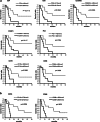Tumor-infiltrating immune cells as potential biomarkers predicting response to treatment and survival in patients with metastatic melanoma receiving ipilimumab therapy
- PMID: 28988380
- PMCID: PMC11028067
- DOI: 10.1007/s00262-017-2072-1
Tumor-infiltrating immune cells as potential biomarkers predicting response to treatment and survival in patients with metastatic melanoma receiving ipilimumab therapy
Abstract
Monoclonal antibodies targeting immune checkpoints are gaining ground in the treatment of melanoma and other cancers, and considerable effort is made to identify biomarkers predicting the efficacy of these therapies. Our retrospective study was performed on surgical tissue samples (52 lymph nodes and 34 cutaneous/subcutaneous metastases) from 30 patients with metastatic melanoma treated with ipilimumab. Using a panel of 11 antibodies against different immune cell types, intratumoral immune cell densities were determined and evaluated in relation to response to ipilimumab treatment and disease outcome. For most markers studied, median immune cell densities were at least two times higher in lymph node metastases compared to skin/subcutaneous ones; therefore, the prognostic and predictive associations of immune cell infiltration were evaluated separately in the two groups of metastases as well as in all samples as a whole. Higher prevalence of several immune cell types was seen in lymph node metastases of the responders compared to non-responders, particularly FOXP3+ cells and CD8+ T lymphocytes. In subcutaneous or cutaneous metastases, on the other hand, significant difference could be observed only in the case of CD16 and CD68. Associations of labeled cell densities with survival were also found for most cell types studied in nodal metastases, and for CD16+ and CD68+ cells in skin/s.c. metastatic cases. Our results corroborate the previous findings suggesting an association between an immunologically active tumor microenvironment and response to ipilimumab treatment, and propose new potential biomarkers for predicting treatment efficacy and disease outcome.
Keywords: Biomarker; Immunotherapy; Ipilimumab; Melanoma; Tumor-infiltrating immune cells.
Conflict of interest statement
Tímea Balatoni has received speaker honoraria and financial support for attending symposia from Bristol-Myers Squibb, MSD Sharp and Dohme (MSD), Novartis, and Roche. Gabriella Liszkay is on the advisory board and has received honoraria for speaking at conferences as well as financial support for educational programs from Bristol-Myers Squibb, GlaxoSmithKline, MSD, Novartis, and Roche. Judit Oláh has acted as a speaker of symposia and consultant for Bristol-Myers Squibb, MSD, Novartis and Roche. Zsuzsanna Lengyel has received speaker honoraria from Bristol-Myers Squibb, MSD, Novartis, and Roche. Gabriella Emri has received speaker honoraria from Bristol-Myers Squibb, MSD, and Roche. All other authors declare that they have no conflict of interest.
Figures




References
-
- Ladányi A, Sebestyén T, Balatoni T, Varga A, Oláh J, Liszkay G. Tumor-infiltrating immune cells as potential biomarkers predicting response to treatment and survival in patients with metastatic melanoma receiving ipilimumab. Eur J Cancer. 2015;51(Suppl 3):S111–112. doi: 10.1016/S0959-8049(16)30325-2. - DOI - PMC - PubMed
Publication types
MeSH terms
Substances
Grants and funding
LinkOut - more resources
Full Text Sources
Other Literature Sources
Medical
Research Materials

